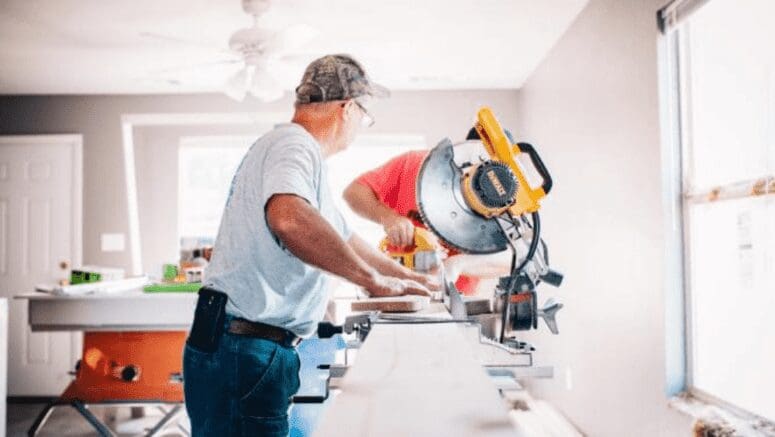Selling a House with Unpermitted Work: Navigate Your Options
- Published on
- 12 min read
- Jody Ellis, Contributing AuthorClose
 Jody Ellis Contributing Author
Jody Ellis Contributing AuthorJody Ellis is a freelance writer with more than 15 years of experience in the writing industry. Her work includes copywriting and content marketing for real estate professionals, stories covering real estate trends and housing markets, and varied articles on decor and design. In addition to buying and selling several homes herself, she's also owned and managed rental properties, and previously worked in mortgage lending.
- Sam Dadofalza, Associate EditorClose
 Sam Dadofalza Associate Editor
Sam Dadofalza Associate EditorSam Dadofalza is an associate editor at HomeLight, where she crafts insightful stories to guide homebuyers and sellers through the intricacies of real estate transactions. She has previously contributed to digital marketing firms and online business publications, honing her skills in creating engaging and informative content.
Making upgrades that increase home value can be a great way to attract buyers when it’s time to sell. While you might think a renovation is as simple as doing (or hiring out) the needed tasks, some projects require a permit before they can happen. Selling a house with unpermitted work could affect its marketability, as well as a buyer’s ability to finance their purchase.
Even if the unpermitted work was done before you lived there, not disclosing it to buyers could mean possible legal trouble if they discover it after the fact. Before you get too alarmed, keep in mind that unpermitted work is fairly common, and there are things you can do to resolve it.
We talked to real estate agents and translated the legalese from real estate attorneys to give you some of the best options for selling a house with unpermitted work.
Can you sell a house with unpermitted work?
Yes, you can sell a house with unpermitted work, and you are required to disclose to buyers any known unpermitted work done on your house, even if it was done by previous owners. Unpermitted work is anything you do to your house that would normally require a permit from your local city building department, yet the permit was not obtained.
Requirements vary by county and state but can include improvements like adding a room, replacing windows, or building a garage.
Even some little projects you can knock out in a weekend could require a permit, explains Silicon Valley-based real estate attorney David Roberson, who’s personally been involved with hundreds of real estate transactions. “There are very few items that you can construct without legally being required to get a permit,” he says.
Projects like interior and exterior painting, new floor installation, and minor electrical repairs probably won’t need a permit, but if you want to add a fence, window, or other major improvement to your home, there’s a good chance you will need one.
For many homeowners, this small detail slips through the cracks and then becomes a problem when they want to put their house on the market.
“I would say out of 10 homes at random, at least four of them would have some form of unpermitted work, 40% to 50%,” says Shawn Engel, a top Denver-area real estate agent. “It could be simple stuff like a deck modification or gutters, all the way up to basement finish.”
What are the risks of selling a home with unpermitted work?
Selling a house with unpermitted work comes with some drawbacks that you should be aware of:
- Lower sale price: Buyers may be hesitant to pay top dollar if they know there’s unpermitted work, which could lead to a lower offer. Or, you may need to lower your price during negotiations.
- Buyer concerns: Unpermitted work could raise red flags for buyers, especially if they worry about safety or compliance with building codes.
- Financing issues: Lenders may refuse to approve a mortgage if they find unpermitted work, which could limit your pool of potential buyers.
- Future liability: If buyers later find issues with the unpermitted work, you could be held legally responsible, even after the sale.
It’s important to understand these risks so you can make informed decisions when selling your home.
How do permits work, and why do you need them?
It might sound like a lot of bureaucracy, but permits are meant to safeguard homeowners. Project permits ensure that the work complies with local policies like land use, zoning, and building codes, ensuring that the structure will be safe for you and any future occupants.
Homeowners sometimes forgo the permit process because they think it can be tedious and complicated.
Process of obtaining a permit
The process for obtaining a permit for work on your house can vary by jurisdiction, but generally looks like this:
- Reach out to your local building permit office. Let them know which project you’re planning. Depending on the complexity of the work you plan to do, you might need multiple permits for construction and electric and plumbing systems.
- Fill out the permit as completely as you can. Include drawings and schematics when possible.
- Submit the permit and pay the filing fee. Depending on the complexity of your project, this permit could be approved on the spot or need additional review. If your permit is approved, you’ll receive an official license.
- Post the permit on your home or close to where you’re completing your project. You’ll need to get the permit before any work is done.
- Have the work officially inspected. Depending on where you live and the particular project, you may need to get an official inspector to check out the work. If the inspector recommends changes, they’ll need to visit again to confirm you’ve made them.
- Remove the permit after approval from the inspector and completion of the project.
How can I tell if my home has unpermitted work?
When it comes time to sell, having a complete and accurate history of work done to your house can be a crucial part of the sales process. But unless you’re the first person to occupy your home, chances are you don’t know everything that’s been done to the property.
As a buyer, you might not have thought to ask the seller about permits when looking at all the great upgrades they made to the house, but now is the time to take a closer look.
Does your house have a garage as an add-on, or did the previous owners build on a third bedroom? Were the bathrooms recently remodeled, was the roof redone, or was a brand-new fence put up right before you bought the house? These projects may have required a permit.
If you think there might be unpermitted improvements to your home, there are a couple of ways you can investigate further:
Look at the home’s original blueprints
If you aren’t sure what work was done to the house before you bought it, one way to find out is to get a copy of and review the house’s original blueprints. You may have a copy in your purchase paperwork, but if you don’t, try searching city records, reaching out to the previous owner if possible, or contacting the original builder. If your neighborhood is part of a homeowners association, you can also contact the HOA directly to see if they can provide a copy.
Once you have the blueprints in hand, you can review them and see if anything that currently exists in your home didn’t exist when the house was built.
Review city building permit records
The best way to find out if your house has unpermitted work is to go down to your city permit offices and look at their records. From there, you can check to see if your home matches the plans of the permits. If not, chances are something was done without approval.
Taking a trip to the city or county building might sound complicated, but “it’s very easy to pull the permits up. There’s no cost to it,” Engel says.
These records can give you the most complete history of your home in regards to permits. Pulling the records yourself also means you’re getting in front of the issue rather than waiting for an inspector or potential buyer to bring it up.
“We’re finding today that the ‘buyer beware’ motto is definitely in play more so than I’ve seen of late,” Engel says. With more information online, buyers are very savvy these days and usually do their own due diligence before putting in an offer.
“And that’s when skeletons in the closet, if you will, get brought up,” Engel adds. “That catches the seller by the tail.”
My house has unpermitted work: What are my options?
If there’s unpermitted work on your property, you’ve got two main options when it comes to the sale of your home.
Option 1: Sell the house as-is
If the idea of resolving unpermitted work issues feels like, well, too much work, you could list the house with the caveat that it is being sold as-is. The problem with selling a house as is is it depends on the amount and type of unpermitted work, owner-occupier buyers could run into financing problems with their bank if you’re selling a house with code violations.
As an alternative, consider HomeLight’s Simple Sale platform. It connects you to one of the largest networks of investor-cash buyers in the country, who specialize in fixing and flipping or buying and holding properties. This enables you to skip the repairs and go straight to the sale.
The transaction is fast, taking no more than a few mouse clicks to start the process. You’ll get an all-cash offer in as few as 24 hours, which can remove much of the stress that goes with selling a house that has unpermitted work.
If you do decide to list your house and go with an as-is sale, make sure to provide full disclosure. Disclosing unpermitted work in the listing is important (and legally required in most cases) so that buyers know what they’re getting into.
“I’ve found over and over in the past 33 years that I’ve practiced real estate that disclosure really puts out any potential issues almost immediately,” Engel says. “And with buyers, it scores big points with them.”
While small, unpermitted projects (as long as they’re clearly disclosed to buyers) might not affect the value of your property, when it comes to large-scale unpermitted work, you may have to consider a lower asking price for your listing since the buyer will have to assume responsibility for the work that was done.
Your agent may even suggest not including the unpermitted work in the calculation of the market value for the home. For example, if you have a two-bedroom property, but the second bedroom was built without a permit, you might choose to value the property as a one-bedroom.
It does, however, depend on your local market. “If it’s a hot market, then there may be a negligible effect. If it’s a buyer’s market, then the buyer has way more leverage over the seller,” Roberson says.
Option 2: Obtain retroactive permits
There is another route you can take. You can go back to the city or county and obtain a permit retroactively on already completed projects.
The cost associated with retroactive permitting will depend on the scope and value of the construction. Before going to the city to obtain a permit, you might want to hire a contractor to examine the existing work. They’ll be able to ballpark the cost of bringing it up to code and will have an idea of how much is already built in accordance with the existing code requirements.
An inspector from the city will come to look at the work and will determine if it was done correctly. In some cases, it might be as simple as the inspector asking you to open up some walls. In others, they might ask you to tear down and rebuild portions of the work, based on their feedback.
If you are obtaining a permit for work done by a previous owner, the city or county may be more lenient with you. They most likely won’t charge you for any penalties a retroactive permit incurs and might give you more flexible deadlines in bringing the work up to code.
Buyers are looking to close usually within 45 days. And if you have a big retroactive inspection permit situation, like on a basement finish, you could be looking at several weeks to a few months to get all of those t’s crossed and i’s dotted.
 Shawn Engel Real Estate AgentClose
Shawn Engel Real Estate AgentClose Shawn Engel Real Estate Agent at RE/MAX Alliance Currently accepting new clients
Shawn Engel Real Estate Agent at RE/MAX Alliance Currently accepting new clients
- Years of Experience 38
- Transactions 369
- Average Price Point $324k
- Single Family Homes 288
Decide before you list!
The decision of selling as-is or obtaining retroactive permits should be made before you list your home, recommends Engel.
“Buyers are looking to close usually within 45 days,” he says. “And if you have a big retroactive inspection permit situation, like on a basement finish, you could be looking at several weeks to a few months to get all of those t’s crossed and i’s dotted.”
The biggest positive of obtaining a retroactive permit is that it allows you to maintain the value of the home, and it makes for an easier sale overall once you know everything is done correctly. “I can tell you from a professional standpoint, it’s worth every dollar,” advises Engel, who says that retroactive permitting can avoid potholes down the road.
Whether you should opt to get a retroactive permit depends on your time and budget. If you’re on a tight timeline and need to sell house fast, you might decide to list your property without permits and disclose the work, understanding that the home could sell for less. If you have the time, getting permits now could mean a smoother sale and higher offers from future buyers.
Other considerations to keep in mind when selling a house with unpermitted work
- Unpermitted work can affect insurance. “For example, if a new electrical panel was installed, but it is not to code and was not inspected, there could be significant insurance ramifications,” Roberson says. The insurer might increase your premiums or cancel the policy altogether.
- If unpermitted work is disclosed, the buyer will assume future responsibility. If unpermitted work was properly disclosed to the buyer, then it becomes their responsibility after the close of escrow.
- If unpermitted work causes damage to the buyer, it could mean legal recourse for the contractor. Even if the buyer knows about the unpermitted work, they may still be able to pursue damages from the contractor. According to Roberson: “If the unpermitted work was done ‘not to code’ and those ‘not to code’ improvements end up causing damage, the buyer may have a cause of action against the contractor who installed the unpermitted work.”
- In most cases, you are legally obligated to disclose all unpermitted work you are aware of, even if it’s from prior owners. Make sure to communicate everything you know about unpermitted work on your property. Withhold information from potential buyers, and you’ve got a potential lawsuit on your hands.
Roberson recently saw a seller lose a court case against a buyer because they failed to disclose unpermitted work “even though they knew it was unpermitted, and the unpermitted addition occurred prior to their ownership.”
Selling your home with unpermitted work can be time-consuming and complicated, but it’s not uncommon. The biggest decisions around permitting should be made before the property is even listed.
Ultimately, it comes down to time and money: Do you have the time to obtain permits before bringing your house to market, or can you afford the price reduction that often accompanies unpermitted work? Or, should you consider a quicker as-is option such as Simple Sale?
With answers to those questions in mind, work with a top local agent to determine the best way to proceed with your sale.
Header Image Source: (Roger Starnes Sr / Unsplash)
